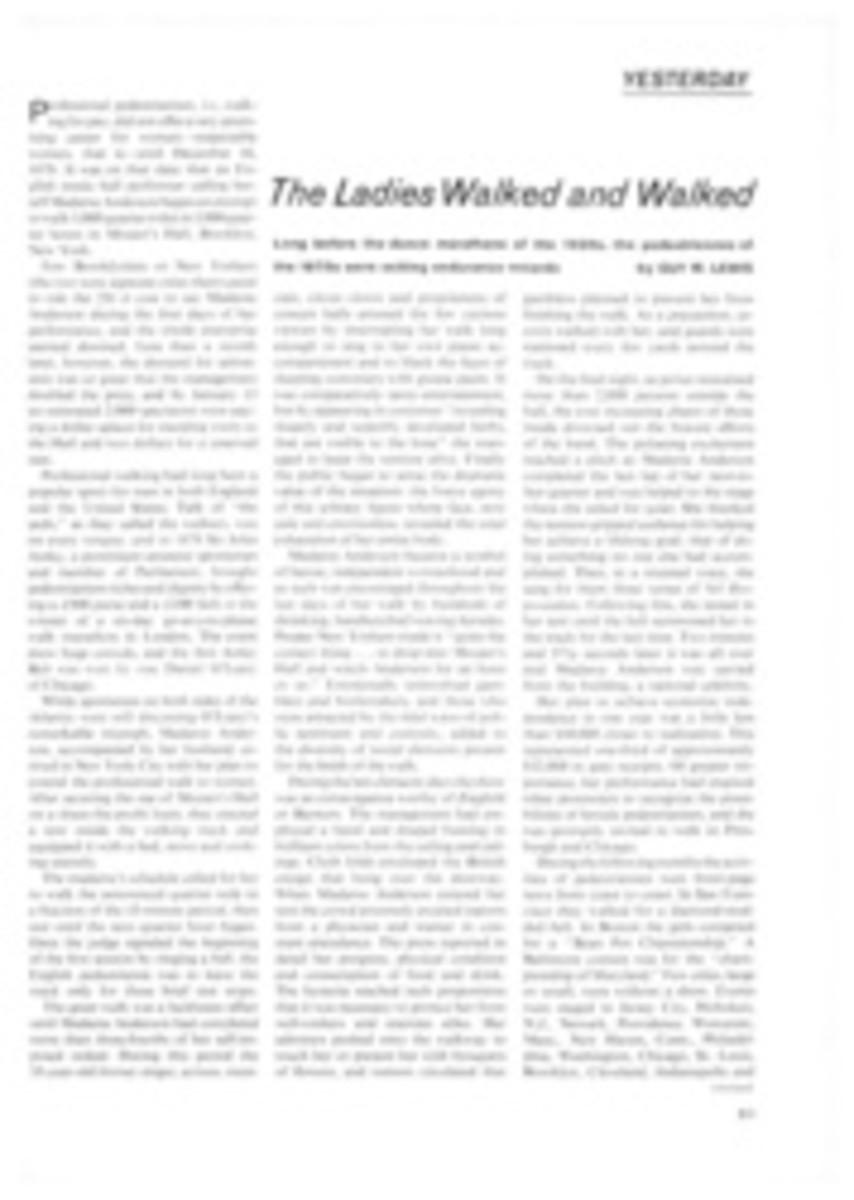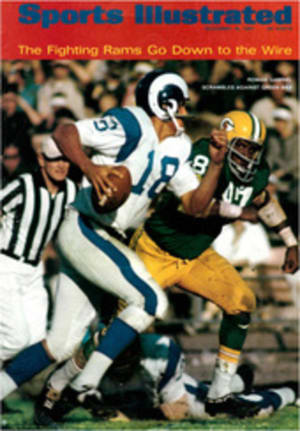
The Ladies Walked and Walked
Professional pedestrianism, i.e., walking for pay, did not offer a very promising career for women—respectable women, that is—until December 16, 1878. It was on that date that an English music hall performer calling herself Madame Anderson began an attempt to walk 3,000 quarter miles in 3,000 quarter hours in Mozart's Hall, Brooklyn, New York.
Few Brooklynites or New Yorkers (the two were separate cities then) cared to risk the 25¢ it cost to see Madame Anderson during the first days of her performance, and the whole enterprise seemed doomed. Less than a month later, however, the demand for admission was so great that the management doubled the price, and by January 13 an estimated 2,000 spectators were paying a dollar apiece for standing room at the Hall and two dollars for a reserved seat.
Professional walking had long been a popular sport for men in both England and the United States. Talk of "the peds," as they called the walkers, was on every tongue, and in 1878 Sir John Astley, a prominent amateur sportsman and member of Parliament, brought pedestrianism riches and dignity by offering a £500 purse and a £100 belt to the winner of a six-day go-as-you-please walk marathon in London. The event drew huge crowds, and the first Astley Belt was won by one Daniel O'Leary of Chicago.
While sportsmen on both sides of the Atlantic were still discussing O'Leary's remarkable triumph, Madame Anderson, accompanied by her husband, arrived in New York City with her plan to extend the professional walk to women. After securing the use of Mozart's Hall on a share-the-profit basis, they erected a tent inside the walking track and equipped it with a bed, stove and cooking utensils.
The madame's schedule called for her to walk the announced quarter mile in a fraction of the 15-minute period, then rest until the next quarter hour began. Once the judge signaled the beginning of the first session by ringing a bell, the English pedestrienne was to leave the track only for these brief rest stops.
The great walk was a lackluster affair until Madame Anderson had completed more than three-fourths of her self-imposed ordeal. During this period the 35-year-old former singer, actress, musician, circus clown and proprietress of concert halls amused the few curious viewers by interrupting her walk long enough to sing to her own piano accompaniment and to black the faces of sleeping customers with grease paint. It was comparatively tame entertainment, but by appearing in costumes "revealing shapely and superbly developed limbs, that are visible to the knee" she managed to keep the venture alive. Finally the public began to sense the dramatic-value of the situation: the brave agony of this solitary figure whose face, now pale and emotionless, revealed the utter exhaustion of her entire body.
Madame Anderson became a symbol of heroic, independent womanhood and as such was encouraged throughout the last days of her walk by hundreds of shrieking, handkerchief-waving females. Proper New Yorkers made it "quite the correct thing...to drop into Mozart's Hall and watch Anderson for an hour or so." Emotionally uninvolved gamblers and bookmakers, and those who were attracted by the tidal wave of public sentiment and curiosity, added to the diversity of social elements present for the finish of the walk.
During the last climactic days the show was an extravaganza worthy of Ziegfeld or Barnum. The management had employed a band and draped bunting in brilliant colors from the ceiling and railings. Cloth folds enveloped the British ensign that hung over the doorway. When Madame Anderson entered her tent the crowd anxiously awaited reports from a physician and trainer in constant attendance. The press reported in detail her progress, physical condition and consumption of food and drink. The hysteria reached such proportions that it was necessary to protect her from well-wishers and enemies alike. Her admirers pushed onto the walkway to touch her or present her with bouquets of flowers, and rumors circulated that gamblers planned to prevent her from finishing the walk. As a precaution, escorts walked with her, and guards were stationed every few yards around the track.
On the final night, as police restrained more than 2,000 persons outside the hall, the ever increasing cheers of those inside drowned out the bravest efforts of the band. The pulsating excitement reached a pitch as Madame Anderson completed the last lap of her next-to-last quarter and was helped to the stage where she asked for quiet. She thanked the tension-gripped audience for helping her achieve a lifelong goal; that of doing something no one else had accomplished. Then, in a strained voice, she sang for them three verses of Nil Desperundum. Following this, she rested in her tent until the bell summoned her to the track for the last time. Two minutes and 37¾ seconds later it was all over and Madame Anderson was carried from the building, a national celebrity.
Her plan to achieve economic independence in one year was a little less than $10,000 closer to realization. This represented one-third of approximately $32,000 in gate receipts. Of greater importance, her performance had inspired other promoters to recognize the possibilities of female pedestrianism, and she was promptly invited to walk in Pittsburgh and Chicago.
During the following months the activities of pedestriennes were front-page news from coast to coast. In San Francisco they walked for a diamond-studded belt. In Boston the girls competed for a "Bean Pot Championship." A Baltimore contest was for the "championship of Maryland." Few cities, large or small, were without a show. Events were staged in Jersey City, Hoboken, N.J., Newark, Providence, Worcester, Mass., New Haven, Conn., Philadelphia, Washington, Chicago, St. Louis, Brooklyn, Cleveland, Indianapolis and Milwaukee. At one time female walkers were performing in a dozen or more locations in and around New York City alone, including Brewster's Hall at Fifth Avenue and 14th Street where simultaneous contests were being held on the second and third floors. One walker was able to transfer the location of her show from a Brooklyn theater to Brewster's Hall without interrupting her performance by traveling during her rest periods.
Bookmakers and gamblers welcomed this new opportunity to juggle odds, and, according to the more prudish editorialists, lecherous or otherwise depraved individuals found the walks a source for satisfying demented sensibilities. The shows were very quickly reduced from the status of athletic contests to sensuous performances and freak shows in which ambitious girls and women were exploited for the sake of profit. Crowds were larger if the girls dressed in a great deal of "cheap silk and cotton velvet and spangles" and covered themselves with a number of strategically placed "embarrassing bows."
Some promoters evidently attributed Madame Anderson's success in part to her foreign origin because one contest had participants from Canada, Ireland, England, Holland, Sweden, Austria, Scotland and Denmark. One Madame LaChapelle of Paris was always a popular contestant. But for those who were not attracted by parades of international beauty there were more provincial charmers. Annie Bartell was affectionately called the "Westchester Milkmaid" because there was something "refreshingly rural" about her performance.
Lulu Loomer, dressed in embroidered blue stockings, pleased the men with her cute mannerism of keeping time with the music as she strode the boards. One shocked reporter wrote of Macie Burns, a 15- or 16-year-old girl, that "the spectacle of so young and respectable a lady exhibiting herself before a crowd of young men was not a pleasing one." But less easily outraged fans with more perverted values derived satisfaction from watching the old and infirm limp around the tracks. "Shouts of laughter" greeted one lame woman as she hobbled about the arena, according to a contemporary critic.
While their most ardent fans looked upon the pedestriennes as heroines, in some quarters of society they were regarded less highly. Fanny Edwards did not improve the image of the female athlete when she accompanied her trainer as he was haled before a court for abandoning his wife and children. She even posted the $200 bond for his release. Following the action, the trainer left "with his mistress, while his poor wife sat crouching in an obscure corner of the courtroom, crying as if her heart would break."
Meanwhile, male walking was thriving as ever. In an Astley Belt Championship in March 1879, Charles Rowell of England defeated O'Leary and three other competitors. His prize amounted to $18,398.13, and the other participants, except O'Leary, shared nearly an equal amount of money. Promoters of female shows quickly recognized the value of the Astley Belt formula, and, on March 26, 1879, 18 women began the race for the Walton Belt and a share of the $1,750 prize money. Only five contestants finished what a reporter for The New York Times labeled "the cruel six days' walking match." One 54-year-old woman, in an extremely debilitated condition, was sent to Bellevue Hospital for medical care, rest and nourishment, and another participant was reported to have "lost her mind." Exhausted women lay unattended in their tents because they had no one to turn to for assistance.
Those who condemned the brutality of the show placed the blame upon the merciless trainers and promoters who forced impoverished walkers to perform without proper care, food or rest. Despite the protests, contests were staged frequently until June, but from July to December the number of matches was so noticeably reduced that many thought that the mania had expended itself. Then in the middle of December 1879, in an evident effort to revive interest in the activity, promoters announced the Grand Ladies' International Tournament for the Championship Belt of the World.
The producers of the contest were reformers. Female pedestrianism, as they viewed it, was an athletic contest, not a gaudy, cheap show. They required each contestant to pledge not to engage in quarreling, loud talking, profane or obscene language, either upon the track or in the tent; to keep herself perfectly neat and clean; not to appear on the track in tights without a dress covering them; and to always have her hair neatly arranged. Each walker was permitted to have only one gentleman in her tent, and she was required to have at least one female attendant. Throughout the race the performers were models of decorum, and their costumes were in good taste. In keeping with the "new look" in female pedestrianism the promoters employed guards and police, but there were no disturbances among the orderly and mannerly spectators.
Following this decorous affair, female pedestrianism understandably ceased to exist in the United States as a profitable spectator sport.
ILLUSTRATION
A CONTEMPORARY ARTIST IMAGINED A SOCIETY BALL DURING THE WALKING MANIA

